Activism
Race and Social Panic at Haverford: A Case Study in Educational Dysfunction
Not so long ago, one might have been able to count on the naturally oppositional reflexes of young adults as a counterbalance to this kind of crowdsourced social panic.
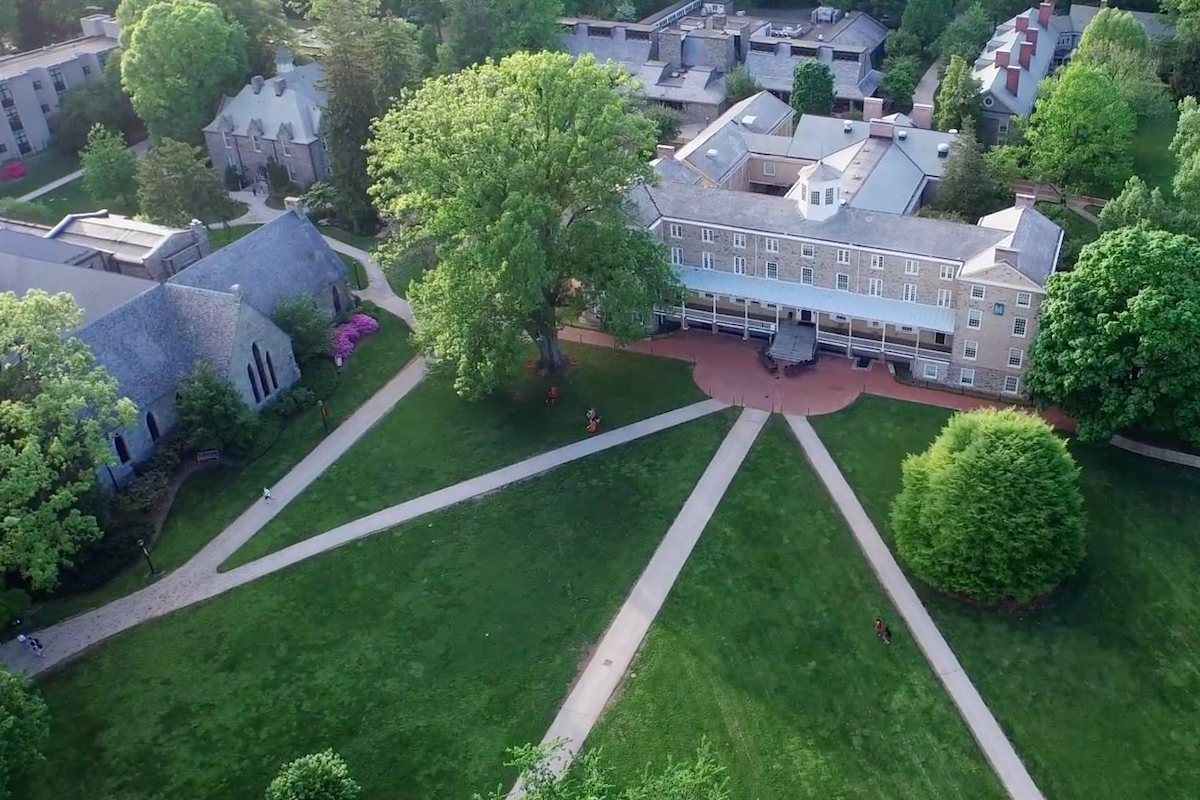
“You have continued to stand as an individual that seems to turn a blind eye to the stuff that’s going on, as a black woman that is in the [college] administration,” said the first-year Haverford College student. “I came to this institution”—and here she pauses for a moment, apparently fighting back tears—“I expected you, of any of us, to stand up and be the icon for black women on this campus… So, I’m not trying to hear anything that you have to say regarding that, due to the fact that you haven’t stood up for us—you never have, and I doubt that you ever will.”
The school-wide November 5th Zoom call, a recording of which has been preserved, was hosted by Wendy Raymond, Haverford’s president. At the time, the elite Pennsylvania liberal arts college was a week into a student strike being staged, according to organizers, to protest “anti-blackness” and the “erasure of marginalized voices.” During the two-hour-and-nine-minute discussion, viewed in real time by many of the school’s 1,350 students, Raymond presented herself as solemnly apologetic for a litany of offenses. She also effusively praised and thanked the striking students for educating her about their pain, while “recognizing that I will never understand what it means to be a person of color or be black or indigenous in the United States. I am a white woman with considerable unearned privilege.”
Not only did Raymond announce that she would be acceding to many of the students’ previously listed demands, she also reacted positively to the new requests that students put forward during the call. “All of the recommendations you’ve made here sound spot on and are excellent,” she said. “We can do those—and go beyond them.”
Since 2015, when Yale rolled over in response to student harassment of two husband-and-wife faculty members, such self-abasement rituals have become common—even if the prevalence of teleconferencing during the COVID-19 pandemic has given us an unprecedented opportunity to watch them unfold. A Haverford president can expect an annual salary of about $500,000. And before coming to the role in 2019, Raymond was a successful scientist who had herself helped smash glass ceilings in several male-dominated academic programs. But the moral hierarchy dictated by social justice runs directly opposite traditional hierarchies of accomplishment and professional authority. And the president’s repeated attempts to ingratiate herself to the students on November 5th made it clear which of these two hierarchies governed the proceedings. One student even saw fit to call out the school’s provost for “multi-tasking while eating on this call, despite the seriousness of this meeting, which we don’t appreciate.”
Similar struggle sessions, ostensibly conducted in the service of social justice, have played out at other colleges and universities in recent months—not to mention artistic and literary foundations, magazines, theaters, and even government agencies. But I found this Zoom call especially shocking, because two of the Haverford administrators who come in for scathing attack on the call are distinguished black educators: Provost Linda Strong-Leek, and Joyce Bylander, Interim Dean of the College.
“I’ll just share that I hear your pain, and I know that this is something that rings hollow for you, but I am a black woman who has lived in a black body for 56 years,” responded Strong-Leek, in carefully measured tones that, among all the responses from administrators, seemed closest to escalating into something approaching candor. “My husband is black. My children are black. Every day, I worry about them and myself. Every day, I confront racism. [I’m] Looking forward to working with you and looking forward to making Haverford a better place.” She seemed to be fighting back her own emotions, but ultimately kept her composure.
The students appeared on Zoom under pseudonyms plucked from a list of past Haverford presidents and benefactors. The idea, a strike organizer self-identifying as “Henry Drinker” is heard to say at the 12:20 mark, was to co-opt the names “of the old white men who have made Haverford the racist institution that it is today.” Drinker, after whom a Haverford student-housing building is named, was a Philadelphia Quaker who personally intervened to help save the famous von Trapp family musicians when they were fleeing the Nazis. “Thomas Tritton,” the name used by the above-quoted first-year student, was Haverford’s president between 1997 and 2007. Tritton is a prominently published chemotherapy researcher who co-chaired the world’s first symposium on organ directed toxicities from cancer drugs, and helped design a ground-breaking course on social justice at Harvard University. None of the students explained how either Drinker or Tritton “made Haverford the racist institution that it is today.”
As for Strong-Leek, all she’s done is earn a PhD; develop an international reputation as a scholar of African literature; create a celebrated program to address the lagging graduation rates of African American and Appalachian men from economically distressed areas; and win a Fulbright Scholarship—whose proceeds she applied to teach the first class on African women writers at the University of Zimbabwe. For her part, Dean Bylander has been spending the fall semester personally overseeing Haverford’s COVID-19 prevention efforts and anti-racism training programs. And yet there she was on Zoom, sitting stoically as students a third her age upbraided her over—of all things—a failure to celebrate “the work that black women and BIPOC have done.”
“I continue to listen and learn, and try to understand the ways in which the college has failed you and how I have failed you,” Dean Bylander calmly responds, ticking off seemingly well-rehearsed talking points. “[I] continue to be committed to trying to work to change and improve the experience of BIPOC students at Haverford.” Her face is a mask of deadpan professionalism. Or maybe she’d simply gone numb.
What follows is the tale of how this sad, surreal scene came to occur. It’s a long story, but also an important one, as the mania that swept Haverford College in late October and early November 2020 lays bare, with unusual clarity, the fervid atmosphere of grievance and self-entitlement that has made the administration of elite colleges and universities so difficult.

* * *
On February 28th, 2020, two weeks before the World Health Organization declared COVID-19 a pandemic, Haverford’s undergraduates convened their Spring Plenary, a biannual forum where students discuss changes to Haverford policies. It is a ritual that many students take seriously. The college was founded in 1833 by Quakers. To this day, it boasts of a tight-knit ethos, by which “Quaker-style community meetings and memorial services provide opportunities to gather together for a common purpose.”
Early in the proceedings, a student group briefed Plenary attendees about its members’ efforts to rejuvenate La Casa Hispanica, a center for Hispanic students. A new alcohol-use policy was ratified. A senior gave a presentation about light pollution on campus, and urged the installation of fixtures “that abide by standards set forth by the International Dark Sky Association.” Several students spoke about how the school could help fight global warming. There was a vigorous discussion about who should be responsible for moving old mini-fridges and microwaves out of student dorms. If this was a campus on the cusp of a race crisis, it was hard to tell. A student-press account of the Plenary does mention racism allegations that were aired. But the only specifics listed in the report regard a controversy surrounding a campus group that had allegedly appropriated Hawaiian culture by throwing a “Hawaiian shirts” event. When a pair of students insisted that the school’s student code must be strengthened to ensure that such incidents of insensitivity don’t reoccur, the existing code was approved by a vote of 929 to 27.
Just months earlier, a Haverford college committee had released a comprehensive report on student attitudes. Like the Plenary, the results betrayed little indication of mass discontent or ideological conflict. Indeed, Haverford appears to be an unusually homogenous institution. Almost all of the students self-identify as “liberal,” while only 3.5 percent self-identify as “conservative” or “very conservative”—barely more than the percentage who self-describe as transgender (three percent). Haverford doesn’t have a Greek system, and, according to the report, “hardly any demographic group seems to be particularly unlikely to attend school-sponsored parties.”
As one might predict, the report focused closely on complaints from members of minority groups who reported witnessing insensitivity among peers. But “an overwhelming majority of respondents also said that the deans, professors, and [then outgoing] President [Kimberly] Benston all cared about them and supported the student body.” To the extent there seemed to be any kind of central schism at the school, the report suggested, the tribalization wasn’t about race or politics, but rather the “athlete/non-athlete divide”: Some varsity athletes complained about being stereotyped as cliquish and coddled, while non-athletes complained, in the words of one student, that sports teams “dominate the party scene” and “almost always sit together.”
When George Floyd was killed on May 25th, Haverford’s campus had been empty for several months. President Raymond, like counterparts at many US colleges and universities, emailed students to express her solidarity with victims of racist violence, and began speaking of the “twin pandemics of COVID-19 and racism.”
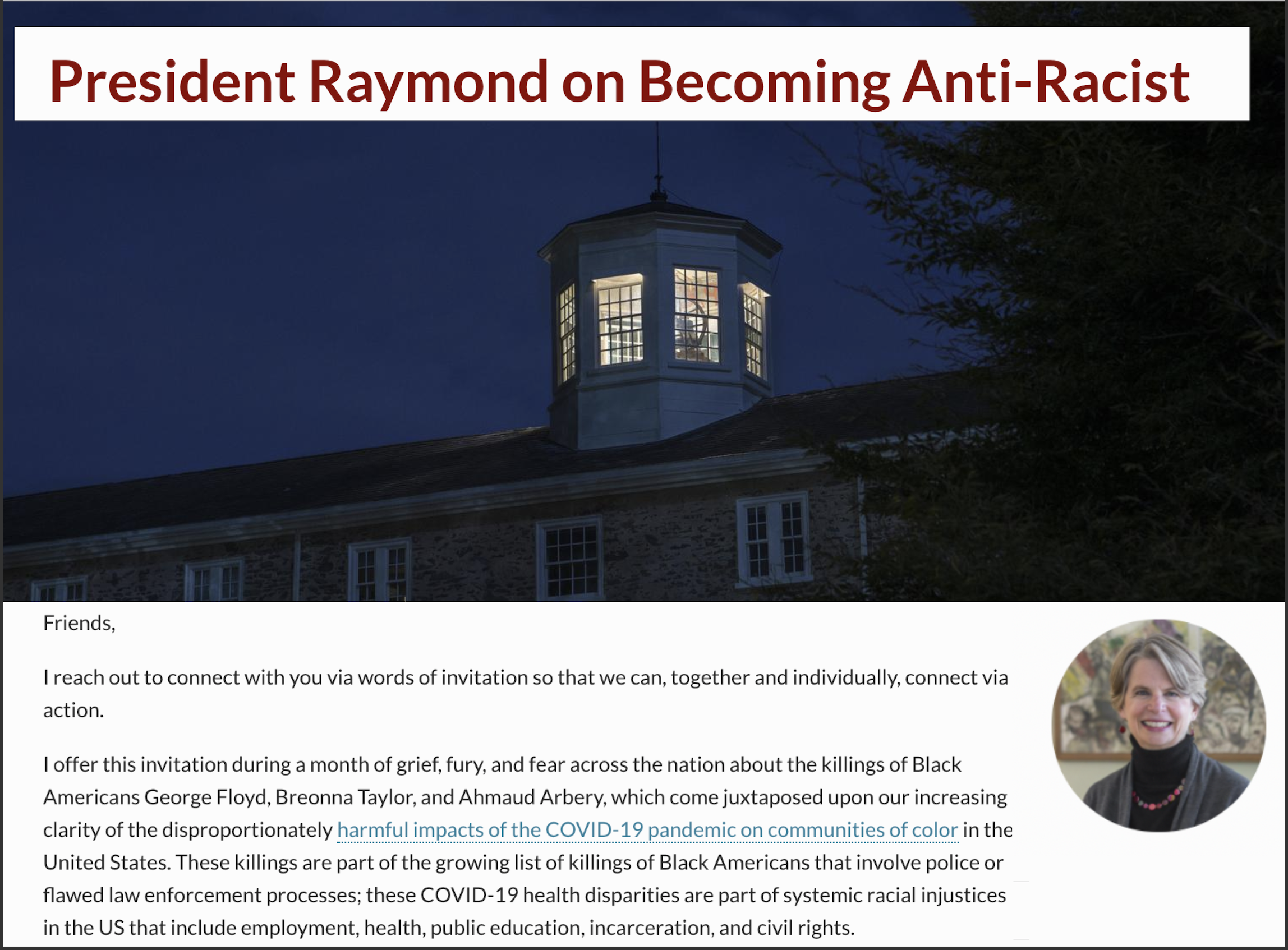
In her June 1st message, titled “On Becoming Anti-Racist,” Raymond noted the disproportionate impact of COVID-19 on non-white people, the “growing list of killings of Black Americans that involve police,” and the “systemic racial injustices” that pervade the United States more generally. She also prescribed an anti-racist reading list, and invited the “White majority at Haverford College… to grow our intellectual, social, and emotional intelligence about racism, inequality, and inequities.”
At around the same time, Haverford black student groups produced a lengthy open letter that itemized their complaints about college life. They also issued demands, ranging from “the College’s formal recognition of Black History Month” to “a course on Blackness and white privilege as part of the college-wide requirements implemented in the next academic year.” But by the time students returned to campus on September 8th, the Black Lives Matter protests already had died down, and the administration’s main focus was on ensuring that Haverford wouldn’t become an infection hub.
Raymond, whose own scientific background in biochemistry, molecular biology, and immunology made her unusually well-qualified in this capacity, set down detailed rules for students, including universal face covering, physical distancing, and journaling of daily contacts. To this day, the school maintains an online dashboard that tracks every single one of the 8,000-plus COVID-19 tests administered to students and employees. Most are tested about once every two weeks. As of November 25th, just 15 positive results had been recorded.
* * *
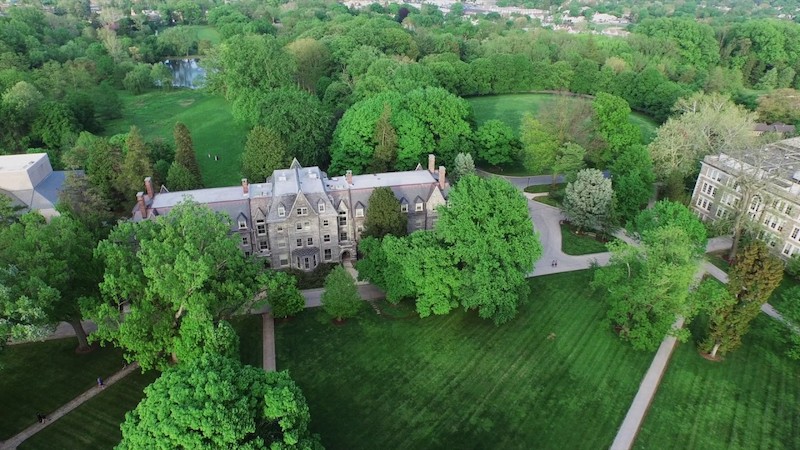
Haverford College takes its name from the surrounding township, an affluent, picturesque, and almost entirely white suburb that, aside from the college, is known primarily for one of America’s most exclusive country clubs. But drive south-east for 15 minutes, and you’ll find yourself in the western neighbourhoods of Philadelphia, the poorest big city in the United States, and the second most dangerous. It was in one of these areas, Cobbs Creek, where, on the afternoon of October 26th, Philadelphia police officers responded to reports that a man was assaulting his elderly mother. When the officers arrived, they found the suspect—a black, bipolar 27-year-old Uber Eats driver named Walter Wallace Jr.—in a state of crisis and armed with a knife. While officers and onlookers yelled at Wallace to put the knife down, he walked out of his house and into the street. Wallace’s mother, Catherine Wallace, can be heard trying to stop police from shooting her son. (The family later told reporters that they’d called for an ambulance, not police.) An incomplete video of these events shows officers backing up before they fire, killing Wallace.
Some family members said that they believed the fatal encounter was the result of poor officer training, not a racist act of murder, and urged Philadelphians not to react violently. Nevertheless, peaceful demonstrations quickly escalated into pitched battles between protestors and police. More than 200 arrests were made. Dozens of police officers were injured, mostly by thrown objects such as bricks, light bulbs, and rocks. In one looting spree that reportedly involved 1,000 people, a Wal-Mart was gutted, and ATMs were demolished. As the week wore on, government officials declared a curfew and brought in the National Guard. At least two Haverford students were arrested and detained at Philadelphia’s 18th Precinct.
These details help contextualize the mass email that Dean Bylander and President Raymond sent to the school community on October 28th, a six-paragraph message that student strikers would cite in the days that followed as proof of the “long tradition of anti-Blackness and the erasure of marginalized voices that have come to characterize the experiences of students of color at Haverford.”
A full copy of the letter is shown in the graphic below. Bylander and Raymond went to great rhetorical lengths to recognize the “grief, exhaustion and anger” that students felt in regard to police shootings of black Americans. Echoing Raymond’s June 1st letter following the killing of George Floyd, the letter effusively pledges the authors to social justice and anti-racism. But the administration also reminded students that there was an ongoing pandemic. Protesting students who brought COVID-19 back to campus could create a wave of infection among classmates, thereby endangering not only members of the school community, but also the families of students who’d be returning home on Thanksgiving—and possibly even forcing the campus to shut down entirely.
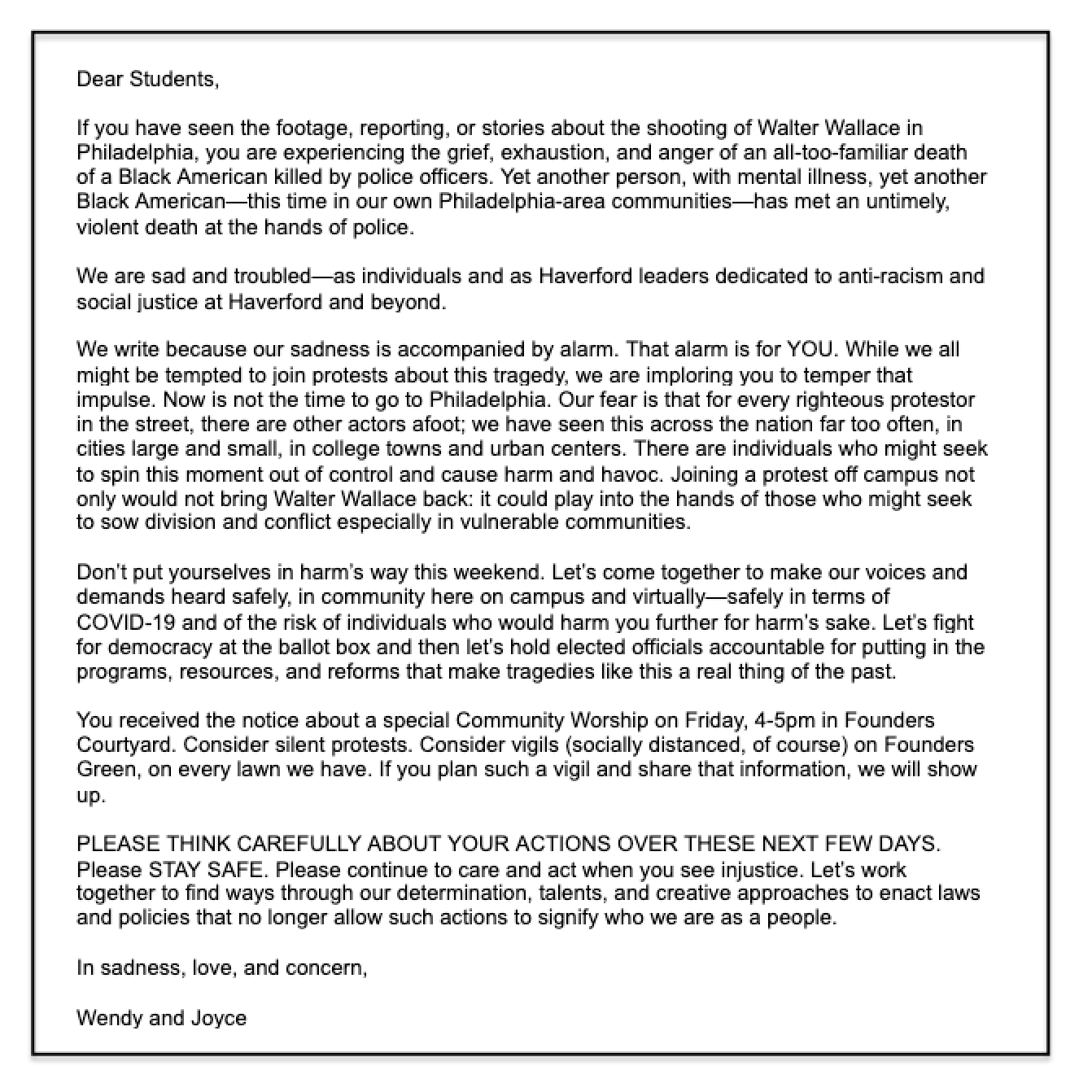
Then there was the more immediate issue of street violence. “There are individuals who might seek to spin this moment out of control and cause harm and havoc,” Raymond and Bylander wrote, which seems as much an allusion to the 2017 Charlottesville car attack and other episodes of right-wing violence as to left-wing groups such as Antifa. The president and dean advised students about a special community worship session on campus, and promised that if students organized a vigil, college administrators would attend.
Within hours, a student named Soha Saghir signaled the fiery response from students, with a widely shared article in the Clerk, a Haverford student newspaper, headlined, “As Black Philadelphians Are Terrorized, I’m Ashamed of What Haverford Has to Say.” Written in the broad, denunciatory, almost apocalyptic tone that would characterize the strikers’ coming manifestos, Saghir assailed the administration’s “enraging” email as serving to “center Haverford students” at a time when “the Black community of Philadelphia is terrorized.” The language was revolutionary: Bylander and Raymond were indulging their parochial mandate to protect Haverford’s tiny institutional bubble at a time when the defining moral drama of our time was playing out on the streets of Philadelphia. Or as Saghir put it, “How can we claim to be anti-racist, if in the face of police brutality inflicted on Black bodies at our doorstep, we choose to close that door and hide inside?”
From this lofty rhetoric, it was but a short jump to the idea that the college itself existed in a state of racialized trauma. By this telling, encoded in the preamble to the strikers’ listed demands, the death of Wallace symbolized a larger poetic truth about the students’ own lives:
This campus has failed its Black students (especially Black women and Black nonbinary people), its students of color, and its FGLI [first-generation low-income] students—the very people whose labor is the backbone of this campus. These emails were just one more way in which you and this institution neither feel nor understand how tired, angry, and ready for change we are… In this pandemic, that labor has intensified in unimaginable ways… We are no longer asking for inclusion or diversity since that gives more power to the institution. Instead, we will disrupt that order. We will be going on a strike from our classes, our jobs (which we need), and any extracurricular activities. This campus can’t run without BIPOC. This is not just a reminder that we are valuable to you on campus, but that our lives, minds, and bodies matter.
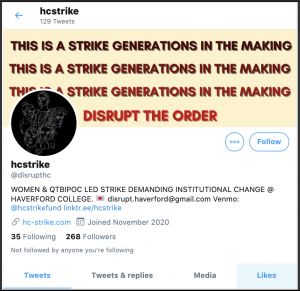
The full text of the strikers’ manifesto runs to nearly 3,000 words, and is written in that strange style of juxtaposition that characterizes many campus social justice manifestos of this type (including the “Open Letter to the Bi-College Community” published by student strikers at nearby Bryn Mawr): Soaring rhetoric about the survival of “lives, minds, and bodies” and a strike that’s “generations in the making” is sprinkled liberally with details that remind us that these students live very privileged lives. Among the Haverford strikers’ demands, for instance: canceled classes on Election Day, official school pronouncements to “honor and credit” student groups that “contributed labor” to the strike, “a framework to deal with problematic professors,” and continued payment for striking student workers who don’t show up for their jobs. As the demands piled up, they were catalogued in a 73-point spreadsheet titled “Anti-Racism Commitments,” which included entries such as “less strict attendance policies and leniency for late assignments,” and “academic leniency for BIPOC and/or FGLI students who are traumatized by the effects of COVID and constant police violence.”
To read through these demands is to understand that Saghir was correct to cast the college as a protected fishbowl, though perhaps not in the way she emphasized: The strikers’ pronouncements are composed in an acronym-littered mash-up of social justice jargon and academic terminology that would be impenetrable to anyone who doesn’t inhabit this kind of privileged milieu. One can only imagine what any ordinary resident of Cobbs Creek would think of the demand that Haverford students get “content warnings from professors for readings that include anti-Blackness, slavery, r*pe, abuse, fatphobia, etc.”; or demand number five, which requires the college to stop exacting “profit off of the romanticized story of [the school’s] Penn Treaty Elm”—the century-old descendant of the tree under which Pennsylvania’s founder made a pact with the Lenni Lenape Nation in 1682.
In the end, the college acceded to almost all of the student demands, except where doing so would be illegal. (And the college did say no to the demand that it literally give away its land to Indigenous peoples, dryly noting that “the College cannot return institutional land without ceasing its educational mission as currently realized.”) Indeed, you can track the school’s compliance in detail on the Anti-Racism Commitments spreadsheet. Installation of “a new plaque at the base of the [Elm] tree,” for instance, has been assigned to the college’s Arboretum, with deliverables due on April 1st, 2021.
* * *
I interviewed five members of the Haverford community about these events—three current students, one recent graduate, and an older graduate who remains active in alumni affairs. Though all of them expressed skepticism of at least some of the strikers’ demands, they generally agreed that systemic racism exists and described themselves as liberal in outlook. What really bothered them, they told me, was what they describe as the strike’s toxic effects on the school community, including the incitement of online mobbings of those who didn’t fall in line with a pro-strike posture. In this regard, they pointed me to an FAQ section on the strike website entitled “What if I don’t want to strike,” in which the organizers denounced anti-strike dissidents as enablers of bigotry: “Know that your reluctance to participate perpetuates, reproduces, and propagates the same colonial and white supremacist systems that advantage certain groups of people over others.”
One of the students I spoke with published his complaints in a pseudonymously bylined November 2nd blog post. “While I am proud of my views and would have no qualms about voicing them openly, I fear the backlash and hostility that would meet me if my identity were released,” wrote “Publius.” “Campus organizations have also directly challenged the morality of those who do not follow the strike, threatening them with social repercussions. One striking campus group sent an email stating ‘Your participation, or the lack thereof, will not be left unnoticed and it represents your support towards the Haverford and larger Black community. You make your stance clear with your actions.’ This statement completely paints over the nuance of the situation at hand. It conflates the demands of the strikers with the well-being of the black community at large, not leaving open the possibility that a student could oppose police brutality and racism but not agree with the tactics or messaging of the strikers.”
The fate of Publius’s blog post helps illustrate its thesis. Originally, he’d written it for a campus newspaper. But upon submission, the author received an editor’s note that read:
Although we would be interested in publishing it—with a few edits—we cannot do so while the strike is ongoing. The paper’s writers and editorial board members, including ourselves, have already committed as individuals and as an institution to support the strike for its full duration… The paper is only operating right now in order to specifically promote and support the movement… There is a time and place for all voices to be heard, and sometimes that requires a consideration of one’s own positionality within the superstructure of intersectional racial dynamics at a place like Haverford
When Publius failed to convince the editors to change their mind, he ran off 800 hard copies of his essay, and then recruited a small group of fellow dissenters to help him distribute them. Though strikers reportedly destroyed some copies, at least one printout made its way to a bulletin board in the political science faculty, whereupon it was posted on the departmental blog.
What made the atmosphere feel so tense, one of the students told me, is that the small, close-knit, consensus-minded values of their Quaker-rooted school were weaponized against dissidents using modern technology: Strike-supporting students were enrolled on a searchable spreadsheet entitled “HC Involvement Strike Form,” a live copy of which (as of this writing) is available for anyone to inspect. And, sure enough, you will indeed find the names of campus newspaper staff members who pledged themselves to “Disrupt all of the college’s daily functions. We are committing to not doing any of these things.” Helpfully, the students have listed all of their classes, jobs, and extracurricular activities, along with their email addresses in some cases, so they can be tracked and possibly reprimanded. As I had my student interviewees on the phone, they stepped me through some of the names on the list—in some cases identifying listed students as sincere social-justice enthusiasts, in other cases as friends whom they knew had signed on merely to avoid social stigma.
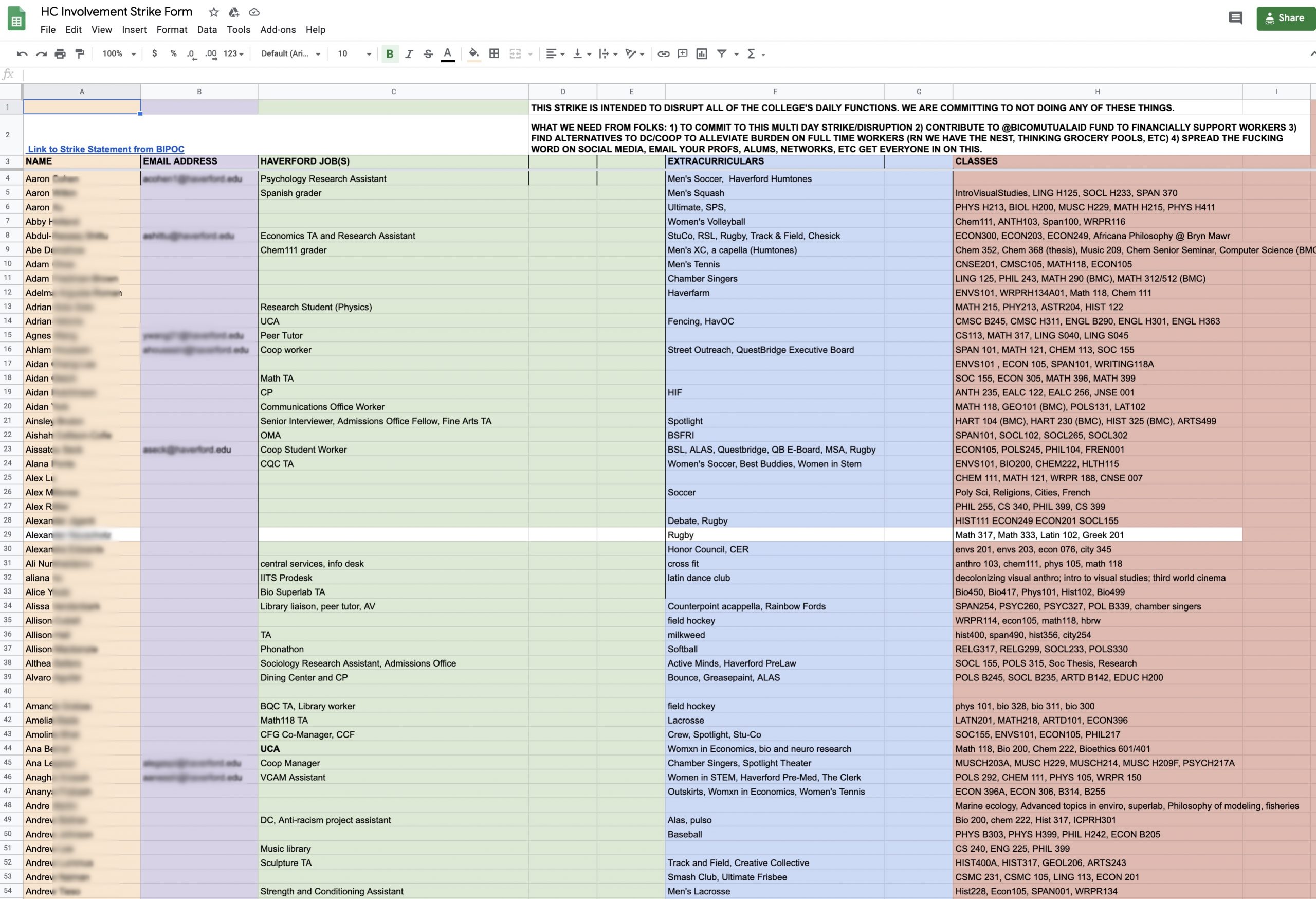
And by “all of the college’s daily functions,” the strikers meant all. Among the activities listed on the spreadsheet: a cappella singing groups, Street Outreach, Women in STEM, Latin Dance Club, Womxn in Economics, Renewal Church, Dean Search Committee, Korean Culture Association, Donkey Ultimate Frisbee, Pre-Vet Society, Chess Club, and, of course, Nerd House. When I expressed incredulity that participants weren’t even allowed to go play chess, one of my interviewees Skype-chatted me a copy of a chess-club email he’d received on November 1st instructing everyone not to show up. The strikers were supposed to be using their time to either support strike activities or, in the words of one interviewee, “stay in and read anti-racist literature.”
On Twitter, meanwhile, strike supporters published the names and contact information of professors who’d refused to cancel classes. Federico Perelmuter, an English major and prominent strike supporter, tweeted “How are there only 650 signatures on that Excel sheet [supporting the strike]? Phantom 500 are a bunch of scabs and I’m gonna find each one of them.” He also tweeted out—as a dark joke, one presumes—“kill peanut,” as well as classmate Eric Beery’s suggestion to “tie bricks to peanut’s legs” and “throw peanut in the duck pond.” Peanut is the name of Haverford President Wendy Raymond’s seven-year-old dog.

Things spiraled further on November 8th, when a visiting history professor, apparently fired up by the strike to the point of emotional crisis, launched an unhinged anti-racism rant on the campus-wide hc-all listserver, in which he cryptically claimed to have a “plan” for taking down the “artificial hierarchy” imposed by white people. When he followed this up by seeking to contact Publius, whose identity was by now known to many, the college reportedly suspended the professor and put Publius up in a hotel room for his own protection.
Within individual academic departments, compartmentalized tempests erupted. A group of several dozen music students, for instance, sent a J’accuse manifesto to faculty who’d refused to cancel classes, accusing them of “complicity [in] anti-Black racism and white supremacy perpetuated by Haverford and by academia as a whole.” In other cases, the performative nature of the strike—along with the associated shaming rituals—unleashed angry salvoes that had no obvious connection to race. When a college group called Friends of Israel tried to add its name to the list of strike-supporting organizations, it was blocked from doing so, with student activists telling members of the group to “get the fuck off the document” and “fucking choke.” More recently, a rumor went around Haverford to the effect that a campus therapist was seeking to turn gay students straight through so-called “conversion therapy.” It was a strange accusation, especially on an ultraliberal campus where, according to the most recent Clearness report, 31 percent of students identify as something other than straight. Yet the rumor became so widespread that the director of the college’s Counseling & Psychological Services had to write a campus-wide memo refuting the claims.
* * *
One of the strikers’ most prominent demands—it appears on the seventh line of the “Commitments” spreadsheet—is the selection of a new chief of diversity, equity, and inclusion for the college. And on November 6th, a day after Raymond and her colleagues had conducted that lengthy Zoom call with strike supporters, the president announced who’d be filling the interim position: none other than Provost Linda Strong-Leek. Raymond herself remains the school’s president, and Joyce Bylander remains dean. Notwithstanding the fact they stood accused of running a racist campus that upholds white supremacy in uncountable ways—charges to which Raymond repeatedly pled guilty—none of these top leaders are leaving.
And why would they? A November 13th article on the Haverford web site, sunnily announcing the end of the strike, proclaimed “Student Protest Brings Racial Equity Advances,” and ticked off the college’s concessions like bullet points in an admissions brochure. The email also dispensed highly specific shoutouts to the same campus activist groups who’d just paralyzed the campus for two weeks—a gesture of praise that had been, itself, one of the strikers’ most oft-articulated demands. The November 13th bulletin further assures everyone that “a digital archive of the strike and student activism is underway in the library and will be available by the end of the academic year.” As part of the settlement, in other words, the school’s administrators are creating an electronic homage to the students who denounced them.
When campus meltdowns of this type occur, you often see conservative culture warriors demand that administrators take a hard line, demonstrate backbone, “grow a spine,” and so forth. But what is their incentive for doing so? It was once the case that a university president was able to balance different constituencies against one another as a means to achieve some kind of policy equilibrium—liberal students versus more conservative professors, administrators against alumni, this department versus that. But that doesn’t happen anymore: Thanks to the homogenizing effects of social media, all of these constituencies tend to be drinking the same bathwater from the same troughs, and so get caught up in the same social panics at the same time.
One of my interviewees was a recent Haverford graduate who’d actually been thrown out of an online alumni group in early November for pushing back against strike cheerleading. He showed me a November 3rd letter, signed by no fewer than 202 alumni, instructing the administration to meet the strikers’ demands. Until such time as that happened, the alumni warned, they’d be “withholding donations to the Haverford College Annual Fund” and “speaking to other alumni of the college and urging them to take the same actions.”
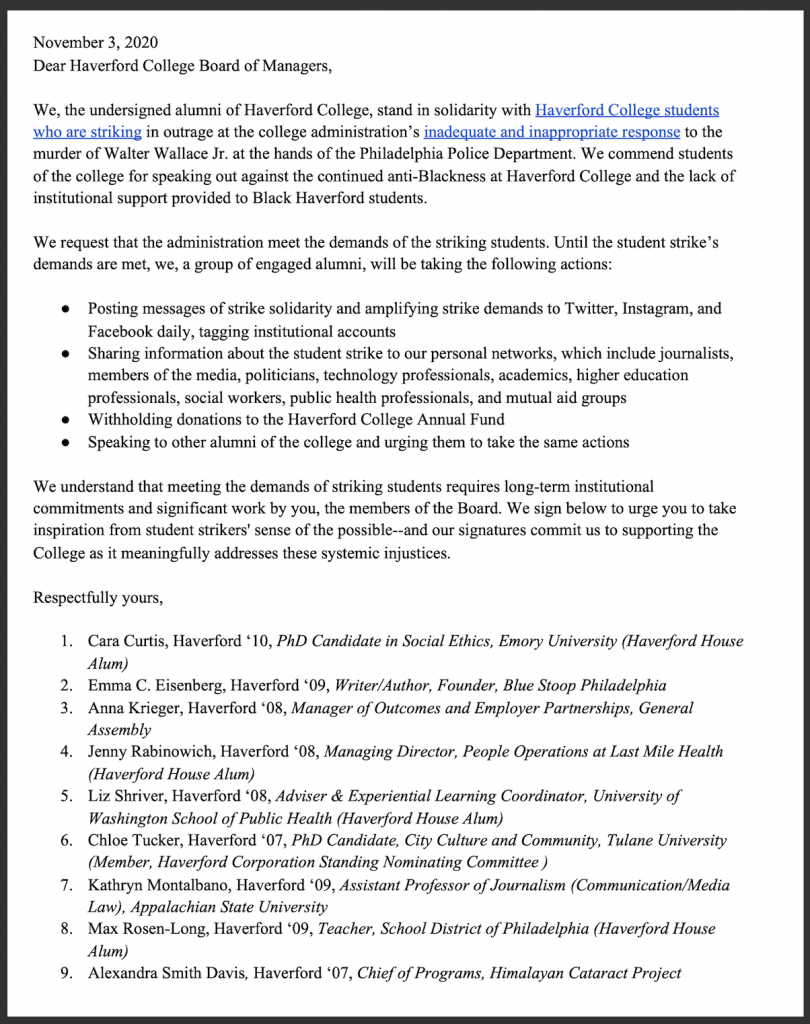
Some professors refused to cancel their classes. But few criticized the strike openly. Some of them even participated in a pro-strike “teach-in,” which instructed students in such topics as “Black Freedom Struggle and Social Movement Theory,” “Identifying and Refusing Characteristics of White Supremacy Culture in Academia,” “Planning for Abolition at Haverford with a STEM Lens: Towards a Mathematics Beyond Police and Prisons,” and “Allyship: Problems and Possibilities.” The administration even assured professors they could count these sessions toward their required 39 instructional hours per course.

This helps explain why some faculty were even more supportive of the strike than their own students. English professor Gustavus Stadler, for instance, tweeted that he was “in awe of the poise, tactical brilliance, and eloquence of the Haverford BIPOC strike leaders after their meeting with faculty today.” While Publius was being denounced in comment threads as a bigot and white supremacist, Stadler was being hailed for his allyship. If you’re a white school president looking to keep her job, which horse sounds like the better choice for your wagon?
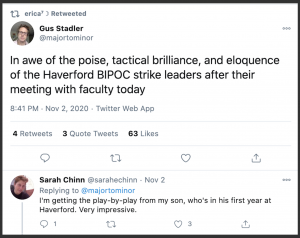
In fact, I’m not really sure that what happened at Haverford actually qualified as a “strike” per se, since the word, in its usual sense, suggests two parties with divergent interests. But as the mutually propagandistic tone of that November 13th college announcement indicated, the college never struck any kind of adversarial posture against the strikers, no matter how extravagant their demands became.
Not so long ago, one might have been able to count on the naturally oppositional reflexes of young adults as a counterbalance to this kind of crowdsourced social panic. But the social justice movement has narrowed the acceptable target set for acts of defiance, encouraging students to reflexively push upstream against both real institutional hierarchies and constructed intersectional hierarchies of race and sex. As I learned in my interviews, moreover, today’s college students have become desensitized to forms of surveillance that their civil-rights forebears would have found intolerable. During the strike, every Haverford student was being monitored by two separate surveillance regimes generating publicly reported data: (1) a COVID-19 testing regime administered by the school, and (2) a crowdsourced peer-to-peer ideological testing regime administered by students themselves. In this kind of environment, the cautionary tales contained in books such as Nineteen Eighty-Four and Brave New World, which once figured prominently in discussions about intellectual conformity, have lost their power.
As for the administration, its leaders know that the best problems to have are the ones you solve with money—especially if that money belongs to the wealthy parents of privileged children. Haverford tuition, which currently stands at about $54,000, presumably will go up to pay for all those promised goodies Raymond agreed to. But having cleverly marketed her concessions as “equity advances,” the college now can claim that it’s simply upselling customers to a better product. And while the treatment of Raymond, Bylander, and Strong-Leek during that Zoom call was mortifying, the strike is now over, and they still have their high-paying jobs. All they traded for them was their dignity. And in a market economy, that’s their decision to make.
* * *
The process of sifting through these events at Haverford has convinced me that the ideological crisis on American campuses can’t be solved by administrators—not because they are beholden to critical race theory, intersectionality, gender ideology, postmodernism, or any of the other bugbears of conservative culture critics, but because they simply have no practical inducements for doing so. Ultimately, this is a crisis that is going to have to be addressed, if at all, by students themselves. And in this regard, I do see some green shoots of hope. Nick Lasinsky, a white undergraduate student at Haverford, wrote a beautiful and thoughtful piece called Why I’ve Chosen Not to Strike. And a black student named Khalil Walker wrote an amazing series of comments in which he demolishes the idea that Haverford is a hive of systematic racism. Our culture moves in cycles, and I predict that you will see more of these brave voices in months to come.
Of all the Haverford community members I spoke with, the only one who asked to be quoted by name was recently graduated philosophy major Alex Gutierrez, who once summarized the mindset of campus activists in an essay about Jacques Lacan. “Modern activists have psyches that are built for the joy of transgression,” he observed. “They engage in activism so they can repeatedly experience that joy, a joy that is denied them in everyday life because everyday life is dominated by the ethics of pleasure… And so they need to invent fictional dominant orders so that they can defy them. This is why protesters would actually be extremely unhappy if oppression went away. They want white patriarchy to be as powerful as possible, so they can defy it.”
Gutierrez wrote these words before his alma mater fell into upheaval in late October. But his analysis seems apt. When students complained that Raymond had caused them “harm” with her October 28th email, they weren’t really speaking up as activists denouncing racism on campus (since there doesn’t seem to be much of it), but as consumers whose parents paid good money for them to experience the sensation of transgressive social-justice heroism. “Normally, the administrators are the perfect target for student transgression,” Gutierrez told me. “They take the abuse and they’re not supposed to push back. That’s part of their role. That’s what students expect.”
Wendy Raymond’s behaviour on that Zoom call shows that she understands these psychological appetites perfectly well, even if her training as a scientist caused her a momentary lapse when she sent that October 28th email. And while she and her colleagues have squandered their dignity and that of their school, I have a certain admiration for the calculating public-relations balancing act they’ve managed to pull off. After all, how many of us could sit there during that Zoom call, keeping our egos and tempers in check while being hectored publicly by some of the most privileged youth in America—and then succeed in passing the check to parents and donors, all the while proclaiming the whole thing a victory for social justice? It’s a rare skill, albeit one that few of us would seek to exercise.






